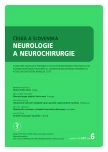Post-traumatic Olfactory Disorders: Case Studies
Authors:
J. Vodička 1,2; K. Pokorný 1; E. Ehler 3; A. Pellant 1,2
Authors‘ workplace:
Klinika otorinolaryngologie a chirurgie hlavy a krku, Krajská nemocnice Pardubice
1; Fakulta zdravotnických studií Univerzity Pardubice
2; Neurologické oddělení, Krajská nemocnice Pardubice
3
Published in:
Cesk Slov Neurol N 2007; 70/103(6): 710-714
Category:
Case Report
Práce vznikla za částečné podpory prostředky výzkumného záměru IGA MZ č.1A/8667-4.
Overview
One of the rare diagnosis of neurological and ENT practice is the posttraumatic olfactory loss. ENT specialist is responsible for the diagnosis of conductive olfactory loss (synechiae of nasal cavity, sinonasal diseases), because conservative or surgical treatment can be efficacious in these cases. The degree of olfactory loss is to be established and malingering is to be excluded. In the paper we present three patients with posttraumatic olfactory loss. The first one suffered laterobasal trauma and simultaneously loss of olfaction. Smell deterioration was stated one month after the trauma by subjective olfactometry. 6 months after the traumatic event the hyposmia was finally diagnosed and simulation of olfactory loss was excluded. The second patient worked in the chemical factory and connected the loss of smell with his workplace. After repeated questions considering head trauma in his history, he addmited fall on his forehead in drunkeness. Based on MRI results the most probable etiology of smell impairment was stated as posttraumatic. In the third case an anosmia after head trauma in the occipital region is described. In the case presentation we focus on the diagnosis of olfactory loss and on the examination of olfaction.
Key words:
posttraumatic olfactory loss – lasting ill effects – olfactometry – malingering
Sources
1. Deems DA, Doty RL, Settle RG, Moore-Gillon V, Shaman P, Mester AF et al. Smell and taste disorders, a study of 750 patients from the University of Pennsylvania Smell and Taste Center. Arch Otolaryngol Head Neck Surg 1991; 117: 519-528.
2. Seiden AM, Duncan HJ. The diagnosis of a conductive olfactory loss. Laryngoscope 2001; 111: 9-14.
3. Jimenez DF, Sundrani S, Barone CM. Posttraumatic anosmia in craniofacial trauma.
J Craniomaxillofac Trauma 1997; 3: 8-15.
4. Becker W, Naumann HH, Pfaltz CR. Ear, nose, and throat diseases. Thieme 1994: 194-196.
5. Frye RE, Schwartz BS, Doty RL. Dose-related effects of cigarette smoking on olfactory function. JAMA 1990; 263: 1233-1236.
6. Vodička J, Chrobok V, Pellant A. Screening of olfactory function using odorized markers. Rhinology, 2007; 45: 164-168.
7. Kobal G, Klimek L, Wolfensberger M, Gudziol H, Temmel A, Owen CM et al. Multicenter investigation of 1,036 subjects using a standardized method for the assessment of olfactory function combining tests of odor identification, odor discrimination, and olfactory thresholds. Eur Arch Otorhinolaryngol 2000; 250: 205-211.
8. Gudziol H, Schubert M, Hummel T. Decreased trigeminal sensitivity in anosmia. ORL J Otorhinolaryngol Relat Spec 2001; 63: 72-75.
9. Yousem DM, Geckle RJ, Bilker WB, Kroger H, Doty RL. Posttraumatic smell loss: relationship of psychophysical tests and volumes of the olfactory bulbs and tracts and the temporal lobes. Acad Radiol 1999; 6: 264-272.
10. Miani C, Bracale AM, Moreschi C, Codarini M, Ortolani F. Post-traumatic anosmia: description of a clinical case, proposal of a standardized protocol and medico-legal comments. Acta Otorhinolaryngol Ital 2002; 22: 142-149.
Labels
Paediatric neurology Neurosurgery NeurologyArticle was published in
Czech and Slovak Neurology and Neurosurgery

2007 Issue 6
- Memantine Eases Daily Life for Patients and Caregivers
- Metamizole vs. Tramadol in Postoperative Analgesia
- Metamizole at a Glance and in Practice – Effective Non-Opioid Analgesic for All Ages
- Memantine in Dementia Therapy – Current Findings and Possible Future Applications
- Advances in the Treatment of Myasthenia Gravis on the Horizon
Most read in this issue
- Facial Palsy
- Swallowing Disorders Related to Vertebrogenic Dysfunctions
- Antibodies Against Glycoconjugates in the Diagnosis of Autoimmune Neuropathies
- Dercum’s Disease (Lipomatosis Dolorosa) – a Rarely Diagnosed Disease: a Case Study
